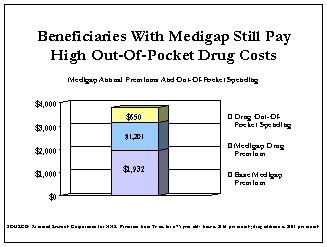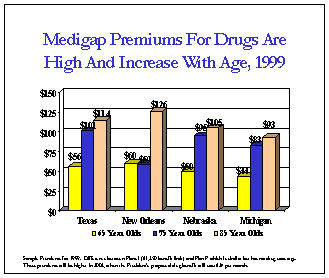MEDIGAP PRESCRIPTION DRUG COVERAGE
Because of its high cost relative to its benefit, less
than one in ten Medicare beneficiaries purchases a Medigap plan with
prescription drugs. Three of the ten standardized Medicare supplemental
plans, (plans H, I, and J) include prescription drug coverage. All three plan
types have a $250 deductible for the drug benefit and require 50 percent
coinsurance. The H and I plans have a cap on drug benefits of $1,250 while the
J plan caps the benefit at $3,000. The typical premium for a plan with the
lower cap costs about $90 per month or $1,080 per year.

Medigap is expensive, inefficient, and often uses higher
prices to discriminate against the oldest beneficiaries.
Expensive. Medigap policies that cover prescription
drugs are expensive relative to comparable policies that do not cover drugs.
Additionally, premiums vary tremendously from place to place, and from
beneficiary to beneficiary. Finally, a beneficiary cannot only pay for
prescription drugs -- they must also buy the other benefits in the package.

Inefficient. Because it is sold to individuals,
Medigap does not offer beneficiaries the kind of premiums that result from
group purchasing. This also adds to the administrative costs per policy, which
are typically two to three times more than that of group coverage.
Costs increase with age as well as health inflation.
This "attained age" pricing practice causes excessive premiums for those who
need it most -- the very old. It also disproportionately affects women since
they comprise nearly three-fourths of people over age 85.
|

